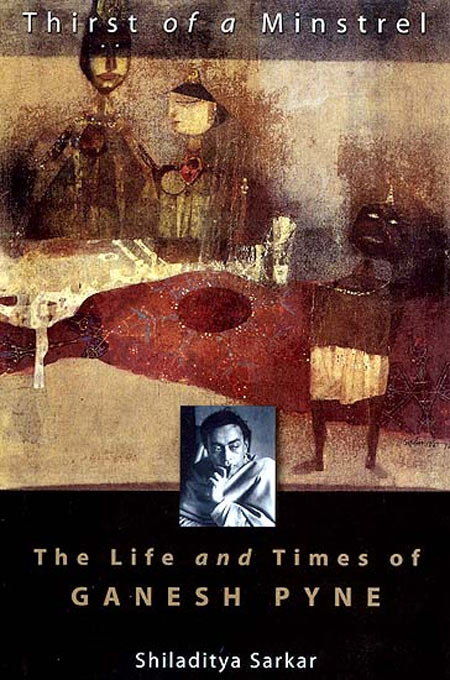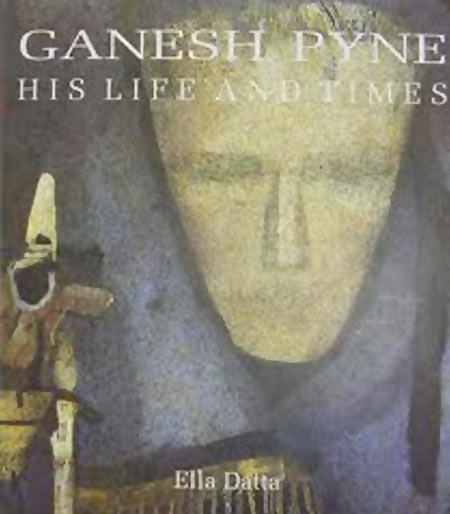Photographs: Courtesy Outlook magazine
Artist Ganesh Pyne, one of the greatest exponents of the Bengal School of Art, was often called the Painter of Darkness.
An artist who delved deeply into philosophy, Pyne's works would sell for anything between Rs 50 lakh to Rs 1 crore. In the 1980s and 1990s, he was one of the highest-priced artists from India.
Pyne, 76, passed away after a cardiac arrest on March 12.
Fellow artist Ramananda Bandyopadhyay pays tribute to one of the legendary painters of our time.
I knew Ganesh Pyne from 1959-60.
I used to live in Purulia (in West Bengal) then.
It was our work that drew us to each other.
We started discussing our art and that's how we became friends.
His early works drew inspiration from the Bengal School (of art), especially its founder Abanindranath Tagore.
One could also draw similarities between his paintings and those of Frans Hals (a Dutch Golden Age painter, notable for his loose painterly brushwork).
He was also influenced by Rembrandt Harmenszoon van Rijn's (one of the greatest painters and printmakers in European art history) handling of chiaroscuro (the use of strong contrasts between light and dark in art) and Paul Klee's simplicity and cubism.
Click NEXT to read about how Pyne became famous
Ramananda Bandyopadhyay spoke to Indrani Roy.
'Ganesh depicted the political outbursts in and around him'
Image: Thirst Of A Ministrel explores the life and times of Ganesh Pyne.Ganesh's canvas revolved mostly around Bengali folklore and mythology.
Like many of his contemporaries, 1970s were the most productive period of the painter's life.
He depicted the political outbursts in and around him on his canvas.
It was during this period that a Mumbai magazine published an article where M F Husain praised Ganesh's work.
That catapulted him into the limelight.
Click NEXT to read about Pyne's reclusive life
'Ganesh lived in an isolated world thronged only by his colours and canvas'
Image: An untitled Ganesh Pyne painting.Ganesh was a recluse.
Silence surrounded him like a steadfast guard, as if shielding him from the trivialities of life.
With time, he disassociated himself from his colleagues and friends, living in an isolated world, thronged only by his colours and canvas.
Was he perturbed by the city squalor? Did political uncertainty that had gripped Bengal over the years disturb him?
As a colleague, I would not be able to comment as Ganesh never unburdened his soul to us.
At one point of time, he almost stopped socialising, attending only a stray event or two.
He confined himself to his south Kolkata residence and spent hours at his studio trying out new forms of art.
His solitude, when expressed through colours, created stout yet lonely, robust yet sad figures that were nothing but reflections of the artist's creative soul.
Click NEXT to read about Pyne's style of painting
'Ganesh's paintings stood for stagnation and death'
Image: A Ganesh Pyne painting titled, simply, 'Mother and Child'.As he grew old, Ganesh concentrated mostly on the tempera (painting executed with pigment ground in a water-soluble medium) form. He experimented with it as much as he could in his relentless exploration of poetic surrealism.
If anyone asks me to assess Ganesh's paintings, I would say they stood for stagnation and death.
In his paintings, there was a lamp and its light but the flame stared back at the viewer without a flicker.
It was a still glow, a motionless statement.
His use of dark colours also accentuated this lack of movement.
Click NEXT to read about the mood of Pyne's paintings
'Ganesh immortalised the stupor that was his signature style'
Image: Ganesh Pyne, His Life and Times by Ella DattaThere was something very serious about his paintings -- the figures were systematically gloomy and shadowy, bereft of a smile that lights up the eyes.
Perhaps Ganesh's political convictions or his ideology motivated him to create such figures.
As an artist I did admire his creativity but also missed the mirth.
Why are Ganesh's creations so sad? Why is there no movement in his paintings, I often questioned myself.
I feel that, in his death, Ganesh immortalised the stupor that was his signature style.
It's a pity that he never founded a school that could teach Ganesh Pyne gharana to his successors.
Ramananda Bandyopadhyay spoke to Indrani Roy.






article